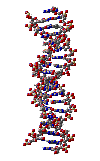|
E-cadherin, that cellular touch so important in cancer (10/2005)
E-cadherin is a molecule involved in adhesion between epithelial cells that also seems to have a protective role in cancer, since its loss is associated with tumour progression and metastases formation in a series of different cancers. How this happens, however, is not clear but new research, about to be published on the journal of Experimental Cell Research1, shows that cells that lose E-cadherin are more resistant to programmed cell death. Programmed cell death, also called apoptosis, is the mechanism by which the body eliminates unwanted or damaged cells, like those that can lead to cancer, by inducing them to die. The research about to be published also suggests that bcl-2 - a protein that affects cell division and whose abnormal production contributes to a variety of cancer - seems to have a role mediating E-cadherin effect. These results, although preliminary, help the understanding of E-cadherin role in cancer and consequently might contribute to the development of new therapeutics.
Cell survival depends on signals from the environment, such as those provided by adhesion molecules that mediate contacts between cells or between cells and the surrounding medium (the matrix). If these interactions cease to exist, the cells are programmed to die, which prevents their migration and growth in places where they do not belong, and consequently, where they have no physiological role. This is particularly important when we think about metastases - a process where cancer spreads to distant sites in the body to establish new tumours - which are associated with 90% of all the cancer deaths.
It is known that loss of adhesion between cells and between cells and the matrix is a pre-requisite for the detachment and migration of the tumour cells, and as a result it is believed that functional adhesion molecules are important in its prevention. One such example is E-cadherin, an adhesion molecule of epithelial cells, which is found altered in several cancers, and that, while intact, stops the tumour spreading into surrounding tissues. E-cadherin is especially interesting if we consider that 80-90% of tumours originate from epithelial cells, even if the majority of those result from accumulation of several mutations in several genes.
Hereditary diffuse gastric cancer (HDGC), however, is a hereditary disease caused by mutations in the E-cadherin gene and in consequence is the perfect model to study the role of this molecule in cancer. And in fact, research in HDGC showed that cancer cells, which do not have a functional E-cadherin, are, not only capable of invading surrounding tissues but also able to survive and grow in the absence of contact with other cells. This last observation has led Gianpaolo Suriano, Raquel Seruca and colleagues from Portugal, Canada and Japan to hypothesize that maybe E-cadherin, when intact, not only prevents the migration of cancerous cells but is also involved in the process of cellular death and so have a dual role in cancer prevention.
To test their theory the team of scientists exposed cells with a functional or a non-functional E-cadherin, as well as cells with no E-cadherin to several stimuli capable of induce cell death, including a chemical used to destroy cancer cells. Confirming their hypothesis, results showed that cells without a functional E-cadherin were 3 to 4 times more resistant to cell death, indicating that this molecule is in fact involved in the mechanism of induced cell death. Also, very interestingly, Suriano and colleagues found that this resistance to death seemed to be mediated through bcl-2, a protein that when over produced leads to cell resistance to apoptosis, a hallmark of malignant processes.
Suriano, Seruca and colleagues’ results support the hypothesis that adhesion molecules are more than simple mediators of cell contact and adhesion and calls for further investigation into these proteins.
The fact that E-cadherin is involved in programmed cell death - a vital biological mechanism that assures the clearance of unwanted cells, that, if not destroyed, could lead to disease, and in extreme cases to malignant processes - is important for the understanding of cancers where E-cadherin function is affected and so, also to the development of future therapies. In fact, if further research confirms that bcl-2 is indeed involved in these type of cancers, therapy presently being developed for bcl-2 might be used in the future to control tumour development, which results from E-cadherin deregulation.
As well worthy of note, is the fact that one of the chemicals employed by the researchers to induce cell death in these experiments, is normally used, together with other drugs, to treat advanced cancers including epithelial tumours resulting from E-cadherin loss. This result questions its effectiveness in this type of tumours and calls for the need of further research on the subject.

1 Experimental Cell Research(15 of October, 2005); Vol 310 (1), pp. 99-104
" Loss of functional E-cadherin renders cells more resistant to the apoptotic agent taxol in vitro”
Original paper’s author
Link to the original paper
|
In collaboration with the Observatório da Ciência e do Ensino Superior (OCES)
Financed by the Fundação para a Ciência e Tecnologia (FCT) |





